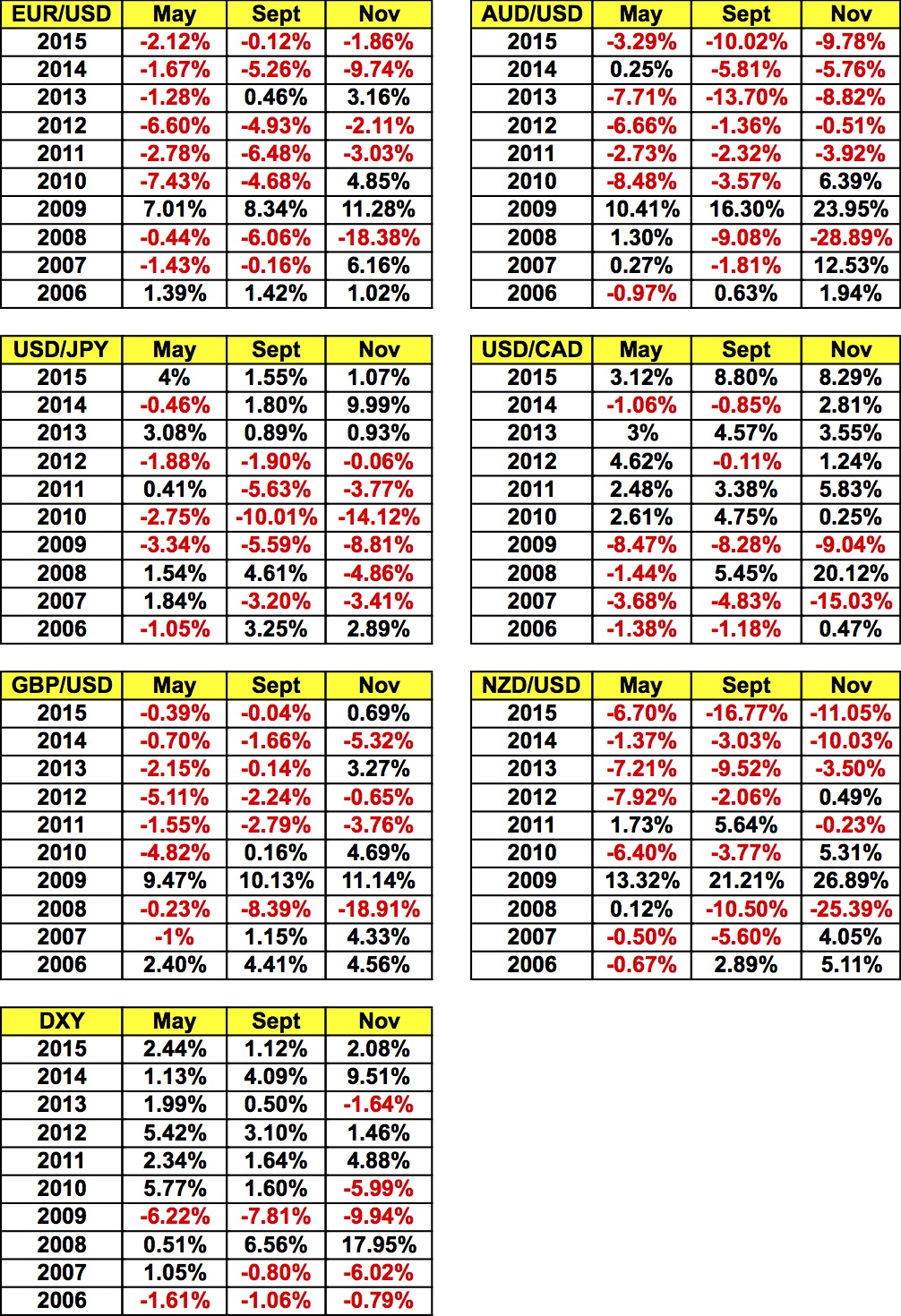By Kathy Lien, Managing Director of FX Strategy for BK Asset Management.
You’ve heard the old saying, 'sell in May and go away'. It’s a well-known investment strategy for stocks that encourages investors to avoid the seasonal slump and volatility in equities by selling in May and returning in the beginning of November. Interestingly enough, this strategy also works in currencies -- but not in the exact same ways. First, simply selling in May and returning in November doesn’t work. In the past 10 years, the US Dollar Index was lower in value in November compared to May only 50% of the time -- which means there’s no discernible pattern at all. This similar behavior was also seen in euro and sterling.
Instead, the strategy to consider is to sell EUR/USD and GBP/USD at the beginning of May, then buy them back at the end of month as these currencies declined in 8 out of the last 10 Mays. Unsurprisingly, buying the dollar (Dollar index) on May 1 and selling it on the last day of the month also netted gains in 8 out of the last 10 years as well. Sellers of the Australian and New Zealand dollars, on the other hand, needed more patience. While the following table shows that AUD/USD fell 6 out of the last 10 years (and rose less than 0.3% during 2 of the remaining 4), the best technique for both currencies is to sell in May and buy back when everyone returns from summer vacation in early September. There was no discernible pattern in USD/JPY but for USD/CAD, buying in May and waiting until November to sell was the best strategy.
Of course every year is different and there are many factors that could make the next few months difficult for investors and EUR/USD in particular. The U.K. referendum in June poses a major risk for all of Europe, the recent strength of the euro could curtail the region’s recovery while the continued impotence of central banks could make investors dubious of the global recovery. There may also be new elections in Europe with Spanish leaders failing to resolve a political stalemate. The migrant crisis fueled nationalism across the continent and is beginning to reshape all of Europe. Many major currencies including euro saw strong gains between early March and late April -- so a correction in May would be natural.
So what could drive the US dollar higher in May? That’s a tough one. The main catalyst is the May G7 Summit. At this stage, the only hope for the world is fiscal stimulus. If host country Japan unveils an aggressive package of new fiscal measures, it will certainly help lift the dollar versus the yen. But what the world really needs is coordinated fiscal stimulus and unfortunately, there’s not enough political will for that to happen. Meanwhile, Monday morning’s ISM manufacturing report is yet another piece of data in a string of softer releases cementing the market’s confidence that U.S. rates will remain steady in June. This week’s Nonfarm Payrolls report won’t reignite demand for the greenback. The problem is not job growth but retail sales and business investment. So unless stocks climb to record highs, the next 2 payroll reports rise 275K or more, average hourly earnings increase consistently AND consumer spending exceeds 0.5% in April and May, they won’t be tightening until September at the earliest. The dollar will rise when investors hit a capitulation point, realizing that they’ve priced everything in as they start to feel that the strong gains in negative-rate currencies are unjustified. Central-bank speak will also be important -- when policymakers finally express their discontent with the rise in their currencies, their words could halt the rallies and drive the U.S. dollar higher in the process.
Meanwhile, USD/JPY remains week and we continue to view the currency pair as a sell on rallies. Japanese markets will be closed from Tuesday to Thursday for Golden Week, so if USD/JPY drips below 106.00 don’t expect any central-bank action even though BoJ Governor Kuroda said he won't hesitate to add stimulus if needed.
Monday evening's main focus was on Australia and the Reserve Bank’s monetary policy announcement. At their last meeting, the RBA left rates unchanged and said, “Under present circumstances, an appreciating exchange rate could complicate the adjustment under way in the economy.” Investors interpreted these comments to mean discomfort with the current level of the currency and sent AUD tumbling lower as a result. There’s a small subset of investors looking for the RBA to ease this month because CPI declined in the first quarter and activity slowed according to the PMIs. However according to the following table, consumer spending rebounded, business confidence improved, the unemployment rate declined and market indicators ticked upward. So like many of their peers, the RBA may wait and see how the economy performs in the next month before taking additional action. The New Zealand dollar also traded higher while lower oil prices kept USD/CAD above 1.2500. No economic data is scheduled for release from Canada Tuesday but New Zealand has its dairy auction. NZD/USD surged above 70 cents Monday and is now trading within arm's reach of its April 0.7054 high.
Sterling also climbed to fresh multi-month highs versus the greenback. While no economic reports were released Monday, the PMI manufacturing index is due on Tuesday. If manufacturing- and service-sector activity grow at a faster pace, GBP/USD could reach 1.4800, while weak numbers could mark a near-term top for GBP/USD, which is still struggling to close above its February high of 1.4670.


